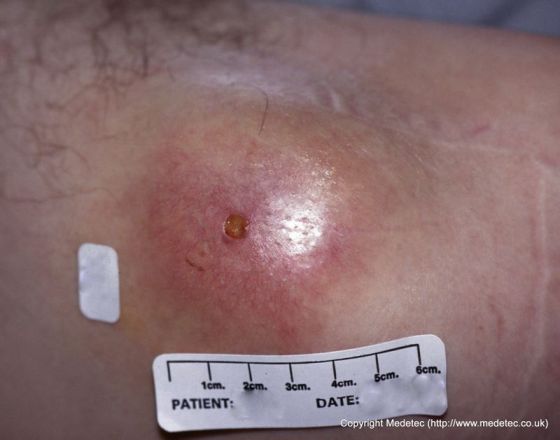At-Risk Patient: Pressure Ulcers/Injuries
A patient at-risk of developing a pressure injury is an individual who has limitations in daily living activities that could result in chronic problems if exposed to pressure, shear, friction or moisture. Bed-ridden patients, especially those with spinal cord injuries, those who are hemodynamically unstable, the elderly and the very young are primarily at risk of developing pressure ulcers.
Patients with nutritional deficits are also at risk of developing pressure injuries, as are those with decreased perfusion rates (i.e., patients who smoke, have diabetes or vascular disease, have poor circulation, etc.), and those who have a history of developing pressure injuries.
Symptoms of Pressure Injuries
A developing pressure injury will present as changes in skin temperature and appearance along with mild discomfort. Blisters may develop in the area.

Etiology
Any injury, disability or age which causes a patient to experience limited mobility puts that patient at risk for the development of pressure ulcers, as does any condition, age, or external factor that results in decreased perfusion.
Risk Factors
In addition to immobility and recuperation from surgery, other factors which may increase the risk of developing pressure ulcers include: poor nutrition, dehydration, diabetes, peripheral vascular disease, low albumin levels/anemia and obesity. Patients exposed to high levels of moisture, friction or shear are also at a dramatically higher risk of developing pressure injuries, especially when these elements occur over a bony prominence.
Complications
Care must be taken that attempts to offload or protect an at-risk limb do not exert pressure elsewhere on the patient's body, putting that area at renewed risk.
Diagnostic Studies
The European Pressure Ulcer Advisory Panel and National Pressure Injury Advisory Panel recommend the adoption of a scale for pressure ulcer risk assessment to be used in conjunction with clinical judgment and an assessment of the patient's skin condition.
Treatment & Prevention of Pressure Injuries
In its most basic form, pressure injury prevention can be as simple as scheduled repositioning of the patient, maintaining proper nutrition, supplementation, and hydration and minimizing shear. Offloading devices, which temporarily protect the affected area from pressure and shear, can be as simple as a pillow placed length-wise under the calf. Offloading boots and devices come in a variety of designs to protect various at-risk locations. They are the primary means for preventing pressure injuries from forming or getting worse. Pressure mapping, the creation of a three-dimensional map of the pressures exerted on the patient, can alert caregivers to areas at risk for pressure ulceration before any symptoms have begun to present.
References
Coyer F, Tayyib N. Risk factors for pressure injury development in critically ill patients in the intensive care unit: a systematic review protocol. Syst Rev. 2017;6(58). https://www.ncbi.nlm.nih.gov/pmc/articles/PMC5359849/ Accessed on December 27, 2019.
Chou R, Dana T, Bougatsos C, et al. Pressure Ulcer Risk Assessment and Prevention: Comparative Effectiveness. Rockville, MD: Agency for Healthcare Research and Quality; 2013.
Bluestein D, Javaheri A. Pressure Ulcers: Prevention, Evaluation, and Management. Am Fam Physician. 2008. 78(10):1186-1194.
European Pressure Ulcer Advisory Panel and National Pressure Ulcer Advisory Panel. Prevention and treatment of pressure ulcers: quick reference guide. Washington, DC: National Pressure Ulcer Advisory Panel; 2009.
National Pressure Ulcers Advisory Panel. Pressure Ulcer Prevention Points. http://www.npuap.org/resources/educational-and-clinical-resources/pressu.... Accessed on October 10, 2019.
Swezey L. Pressure Mapping for Pressure Ulcer Prevention: What Nurses Should Know. WoundSource. 2012. http://www.woundsource.com/blog/pressure-mapping-pressure-ulcer-preventi.... Accessed on October 10, 2019.
Swezey L. Prevention Heel Pressure Ulcers: Simple Methods and Identifying Risk Factors. WoundSource. 2011. http://www.woundsource.com/blog/preventing-heel-pressure-ulcers-simple-m.... Accessed on October 10, 2019.
Image copyright Medetec (www.medetec.co.uk). Used with permission.








Follow WoundSource
Tweets by WoundSource